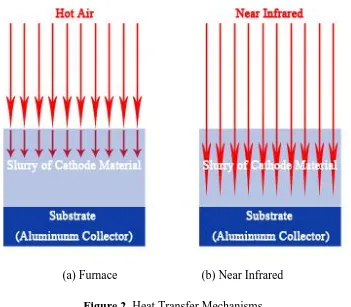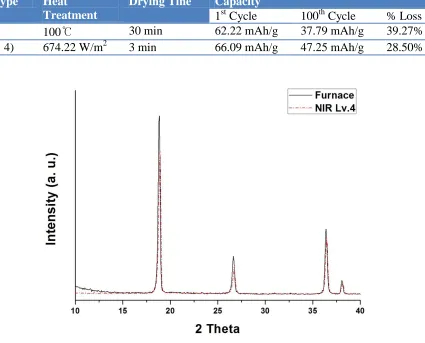Int. J. Electrochem. Sci., 6 (2011) 5462 - 5469
International Journal of
ELECTROCHEMICAL
SCIENCE
www.electrochemsci.org
Short Communications
A Study on Improving Drying Performance of Spinel Type
LiMn
2O
4as a Cathode Material for Lithium Ion Battery
Sung Yeon Kimand Sehun Rhee*
Department of Mechanical Engineering, Hanyang University, 17 Haengdang-Dong, Seoul, 133-791, Korea
*
E-mail: srhee@hanyang.ac.kr
Received: 15 September 2011 / Accepted: 17 October 2011 / Published: 1 November 2011
Lithium ion battery is one of the popular power sources for electronic devices. Although various cathode materials have been studied for lithium ion battery, spinel type LiMn2O4 is more attractive than any other materials due to its low cost, low toxic and high rate. Recently, researches and developments on spinel type LiMn2O4 have been carried out to improve its electrochemical performance. In this work, especially drying process with respect to spinel type LiMn2O4 thin film electrode by using NIR drying process was investigated. NIR technology is expected to be used in roll-to-roll process for manufacturing lithium ion battery. NIR drying process, contrary to conventional drying process, furnace, was verified to be necessary less time and provide longer life cycle. It is estimated that the spinel type LiMn2O4 thin film electrode using NIR drying process can provide more path for lithium ions.
Keywords: Roll-to-Roll Process, Drying Process, NIR Technology, Spinel Type, Lithium Ion Battery
1. INTRODUCTION
1.1 Spinel Type LiMn2O4
1.2 Thin Film Electrode by Slot Die Roll-to-Roll Process
[image:2.596.69.523.306.576.2]Due to high energy density, cathode materials of lithium ion battery can be used in thin film. Thin films of cathode materials are usually prepared by chemical vapor deposition [10,11], sputtering [12-14], e-beam evaporation [15-16], pulse laser deposition [17] and sol-gel method [18]. However these processes require high cost equipment. In order to commercialize the thin film electrode, the process preparing thin film must be simple and require low cost. Printing process using slot die roll-to-roll coating system [19] is expected to be fast and stable. Figure 1 shows a schematic of roll-to-roll-to-roll-to-roll process. The process is conducted while the substrate moves toward the winding roll from the unwinding roll. The first step is pumping the slurry of cathode material into the slot die. Then cathode material can be coated on the substrate (aluminum collector). The next step is drying the slurry coated electrode by drying system.
Figure 1. Schematic of Roll-to-Roll System with Drying Process
1.3 Near Infrared Drying Process
wave permeates into the slurry of cathode material and evaporates the entire area of solvent simultaneously. Therefore, drying is to be fast. And so, NIR drying process is expected to be an appropriate drying process for roll-to-roll process. In this work, drying performance of using NIR drying process has been conducted and analyzed the electrochemical performance of spinel type LiMn2O4.
[image:3.596.125.476.190.497.2](a) Furnace (b) Near Infrared Figure 2. Heat Transfer Mechanisms
2. EXPERIMENTAL
The material used for anode was graphite coated thin film and the electrolyte used was 1.2 M LiPF6 dissolved in a solution containing ethylene carbonate (EC) and ethyl-methyl carbonate (EMC) in a ratio of 3 to 7 by Techno Semichem, a company developing liquid electrolyte. The material used for cathode was aluminum doped spinel type LiMn2O4 by Phoenix PDE, a company developing cathode materials. Slurry of cathode material contains 85 wt. % of aluminum doped spinel type LiMn2O4, 3.75 wt. % of graphite, 3.75 wt. % of carbon and 7.5 wt. % of binder (PVDF) dissolved in NMP (N-Methly-2-Pyrrolide) solution.
the thin film electrode reduces to 50 ㎛. Thin film electrodes were dried by 110℃ for 30 minutes with furnace. And also those were dried by heat flux 299.65 W/m2, 674.22 W/m2, 1030.05 W/m2 and 1310.97 W/m2 for 3 minutes for each, with NIR drying system. And the values of heat flux were determined by a specification of the equipment. Heat fluxes were measured with each level (Lv. 3, 4, 5 and 6) [20].
Charging and discharging was conducted for 100 cycles, with 0.1 C-rate for the first 2 cycles and 1 C-rate for the 100 cycles. Analysis of the phases of the thin film electrode was performed by XRD. And morphologies of the thin film were observed by SEM. And sheet resistances were also measured.
3. RESULTS AND DISCUSSION
[image:4.596.92.477.319.611.2]3.1 Furnace and Near Infrared Drying Process
Figure 3. Life Cycles of Lithium Ion battery using Thin Film Electrode dried by Furnace and NIR
radiation, which causes the vibration of the molecules by activating the molecules directly. It vibrates the molecules and generates heat and evaporates the solvent from the slurry of cathode material. And so, the rapid drying is possible by using NIR drying process.
[image:5.596.37.558.297.364.2]Figure 3 indicates the result of the capacity of the lithium ion batteries made by thin film electrode dried by furnace and NIR. And the capacity and the percentage of the capacity loss of two different types are expressed numerically in Table 1. The most interesting result is that the capacity of the lithium ion battery is larger in case of lithium ion battery using thin film electrode dried by NIR. And after the 100 cycles of charging and discharging, 39.27% of the capacity of lithium ion battery using thin film electrode dried by furnace fades out, and 28.50% of the capacity fades out in case of NIR drying process. The fade out ratio of the capacity has been reduced by NIR drying process.
Table 1. Capacities of Lithium Ion Battery using Thin Film Electrode dried by Furnace and NIR
Drying type Heat Treatment
Drying Tine Capacity
1st Cycle 100th Cycle % Loss
Furnace 100℃ 30 min 62.22 mAh/g 37.79 mAh/g 39.27%
NIR (Lv. 4) 674.22 W/m2 3 min 66.09 mAh/g 47.25 mAh/g 28.50%
Figure 4. Result of XRD of Spinel Type LiMn2O4 Thin Film Electrode
[image:5.596.89.514.306.649.2]
NIR. The lower intensity is considered to have more cavities. And it is also regarded that because of these cavities, the sheet resistance increases. It is estimated that the lower intensity with more cavities provides more paths for lithium ions and causes the increase of the capacity and reduces the capacity fade out on cycling, simultaneously. Therefore, the reasons for increased capacity and less capacity loss of electrode on cycling are estimated as followed; NIR drying process causes the higher efficiency by providing more paths for lithium ions.
(a) Furnace x5K (b) Furnace x10K
[image:6.596.75.522.195.553.2]
(c) NIR Lv.4 x5K (d) NIR Lv.4 x10K
Figure 5. SEM Images of Spinel Type LiMn2O4 Thin Film Electrode
Table 2. Sheet Resistance of Thin Film Electrode dried by Furnace and NIR
Furnace NIR (Lv.4)
Sheet Resistance (mΩ/□) 2.003 ~ 3.284 2.304 ~ 3.564
3.2 Near Infrared Drying Process in Different Heat Flux
[image:7.596.55.546.192.287.2]
Lv. 6) of NIR for 3 minutes. In case of Lv. 2 of NIR drying process, after 10 minutes, solvent evaporated completely. And in case of Lv. 7 of NIR drying process, the fire erupted after 27 second. Therefore the electrochemical performances of both cases were not measured. The capacity and the percentage of the capacity loss were measured.
Table 3. Capacities of Lithium Ion Battery using Thin Film Electrode dried by NIR Lv. 3, 4, 5 and 6
NIR Level Heat Flux Drying Tine Capacity
1st Cycle 100th Cycle % Loss
Lv. 3 299.65 W/m2 3 min 32.55 mAh/g 7.56 mAh/g 76.77%
Lv. 4 674.22 W/m2 3 min 66.09 mAh/g 47.25 mAh/g 28.50%
Lv. 5 1030.05 W/m2 3 min 99.27 mAh/g 84.18 mAh/g 15.19% Lv. 6 1310.97 W/m2 3 min 50.11 mAh/g 28.49 mAh/g 43.15%
The capacity and the percentage of the capacity loss of four different types are expressed numerically in Table 3. As it is shown, after 100 cycles of charging and discharging, 76.77% of the capacity of lithium ion battery using thin film electrode dried by NIR with heat flux 299.65 W/m2 (Lv. 3) fades out, 28.50 % fades out in case of NIR with heat flux 674.22 W/m2 (Lv. 4), only 15.19% fades out in case of NIR with heat flux 1030.05 W/m2 (Lv. 5), and 43.15% fades out in case of NIR with heat flux 1310.97 W/m2 (Lv. 6). In case of lithium ion battery using thin film electrode dried by NIR with heat flux 1030.05 W/m2 (Lv. 5) verified to have best life cycle contrary to other heat fluxes. And also the capacity is larger in the same case than any other heat fluxes. Interesting result in case of lithium ion battery using thin film electrode dried by NIR with heat flux 299.65 W/m2 (Lv. 3) and 1310.97 W/m2 (Lv. 6) have been observed. The capacity is even worse than furnace. It is estimated that the heat energy wasn’t enough to evaporate the solvent sufficiently, in case of NIR with heat flux 299.65 W/m2 (Lv. 3). And in case of NIR with heat flux 1310.97 W/m2 (Lv. 6), it is estimated that the heat energy was oversupplied, so the binder was over heated and act up. It was verified that the cathode material was easily detached with the aluminum collector. Thus the capacities are even worse in both cases. Therefore, the electrochemical performance in case of NIR with heat flux 1030.05 W/m2 (Lv. 5) was verified to be the best.
4. CONCLUSION
fluxes of NIR drying process reduced the capacity loss. In case of NIR with heat flux 299.65 W/m2 (Lv. 3), the solvent didn’t evaporate sufficiently, and in case of NIR heat flux 13310.97 W/m2 (Lv. 6), the binder acted up. And so, the electrochemical performance of lithium ion battery was even worse than furnace. The best NIR drying condition for spinel type LiMn2O4 thin film electrode was verified to be heat flux 1030.05 W/m2 (Lv. 5).
References
1. K. Ozawa, Lithium Ion Rechargeable Batteries, Wiley-VCH (2009)
2. K. E. Aifantis, Stephen A. Hachney and R. Vasant Kumar, High Energy Density Lithium Batteries: Materials, Engineering, Applications, Wiley-VCH (2010)
3. J. N. Remers and J. R. Dahn, J. Electrochem. Soc. 139 (1992) 2019.
4. K. Mizushima, P. C. Jones, P. J. Wiseman and J. B. Goodenough, Mat. Res. Bull. 15 (1980) 783. 5. J. B. Goodenough, G. Wichham and W. J. Croft, J. Phys. Chem. Solids 5 (1958) 382.
6. E. Plichta, S. Slane and H. W. Lin, J. Electrochem. Soc. 136 (1989) 1865.
7. J. M. Tarascon, W. R. Mckinnon, F. Coowar, T. N. Bownmer, G. A. Matucci and D. Guyomard, J. E lectrochem. Soc. 141 (1994) 1421.
8. J. M. Tarascon and D. Guyomard, J. Electrochem. Soc. 138 (1991) 2864. 9. D. Guyomard and J. M. Tarascon, J. Electrochem. Soc. 139 (1992) 937.
10.P. Fragnaud, R. Nagarajan, K. M. Schleich and D. Vujic, J. Power Sources 54 (1995) 362. 11.P. Fragnaud and D. M. Schleich, Sensors and Actuators A 51 (1995) 21.
12.K. H. Hwang, S. H. Lee and S. K. Joo, J. Power Sources 54 (1995) 224.
13.K. H. Hwand, S. H. Lee and S. K. Joo, J. Electrochem. Soc. 141 (12) (1994) 3296.
14.J. B. Bates, G. R. Gruzalski, N. J. Dudney, C. F. Luck and X. Yu, Solid State Ionics 70/71 (1994) 61 9.
15.J. B. Bates, N. J. Dudney, D. C. Lubben, G. R. Gruzalski, B. S. Kwak, X. Yu and R. A. Zuhr, J. Po wer Sources 54 (1005) 58.
16.S. J. Lee, J. K. Lee, D. W. Kim and H. K. Baik, J. Electrochem. Soc. 143 (11) (1996) L368. 17.K. A. Striebel, C. Z. Deng, S. J. Wen and E. J. Cairns, J. Electrochem. Soc. 143 (6) (1996) 1821. 18.Y. J. Park, J. G. Kim, M. K. Kim, H. T. Chung, W. S. Um, M. H. Kim and H.G. Kim, J. Power Sour
ces 76 (1998) 41.
19.C. Lee, H. Kang, H. Kim, Ho Anh Duc Nguyen and K. Shin, J. Mech. Sci. and Tech. 24 (2010) 315. 20.J. Park and S. Rhee, Jap. J. Appl. Phys. 49 (2010) 05EC10.





